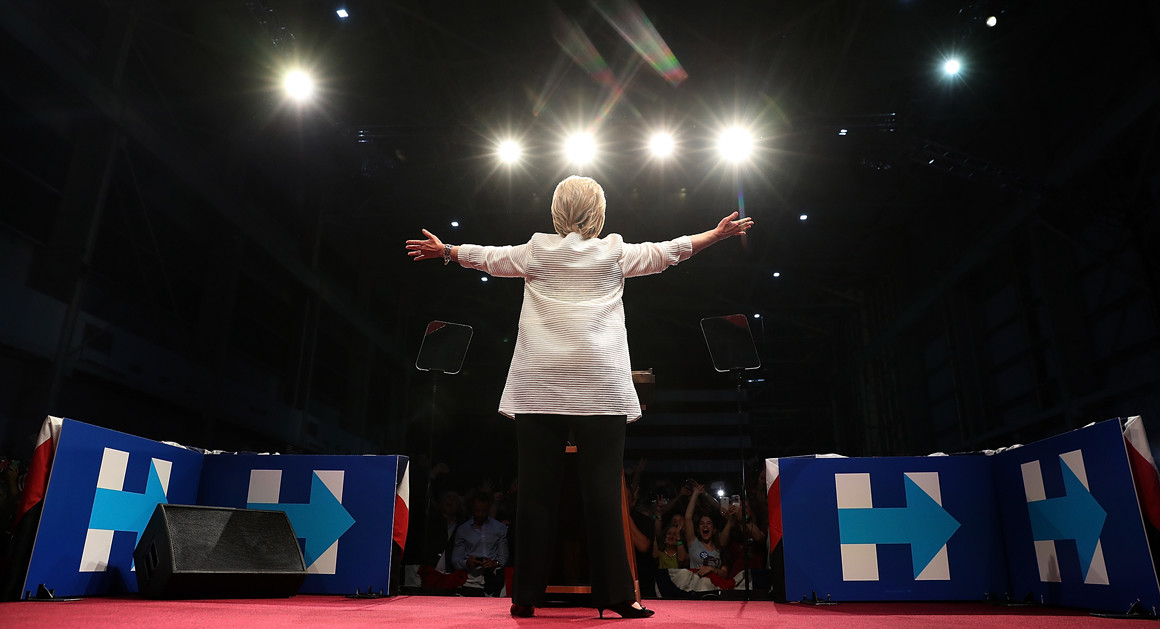JUNE 8, 2016
Photo: AP
Well now there’s no question.
On Tuesday night, Hillary Clinton won four Democratic primaries, including the big one (California), and not only passed the required number of delegates (which the AP and NBC News claimed she passed on Monday night) but also a majority of the pledged delegates that are bound to vote for her on the first ballot. By the measurement always used by the Democratic Party, Clinton is now the presumptive Democratic nominee.
After news of that historic moment broke, a capacity crowd at the Brooklyn Navy Yard roared at the appearance of Clinton who delivered a moving acceptance speech that cited the achievements of women, not only those on the civil rights front but also the women in her own life, particularly her mother, Dorothy Rodham. The enthusiasm (and size) of the crowd were very reminiscent of that of a Bernie Sanders rally, and while these big-crowd events have not always proven to be Clinton’s most effective venue, her speech hit just the right tone on Tuesday night, very reminiscent of her effective dissection of Donald Trump in San Diego last Thursday.
For his part, Trump, who swept all five Republican primaries on Tuesday, offered a very different kind of acceptance speech. Surrounded by family within the safe confines of his Westchester County country club, Trump, who has been hammered for his undisciplined, off-the cuff speechmaking, used a teleprompter for only the fifth time in this campaign. The teleprompter is not Donald Trump’s friend, and he read his mediocre speech with a stiffness uncharacteristic of the GOP showman. But he did keep on script.
That decision was necessary because of yet another awful day in the Trump campaign. Trump issued a statement regarding his controversial racial criticism of an Indiana-born Federal judge of Mexican ancestry, which offered no apology but instead blamed others who have “misconstrued” his remarks. Senate Majority Leader Mitch McConnell (R-KY) reiterated his call for Trump to apologize, House Speaker Paul Ryan (R-WI) once against called Trump’s remarks “racist” (but he’s still supporting him) and Sen. Mark Kirk (R-IL) fully rescinded his endorsement of the GOP front-runner. Conservatives in particular have been critical of Trump, alleging that he has completely squandered the five-week head start since he clinched the GOP title — while he could have used to mend fences and develop an effective anti-Clinton strategy — but wasted it instead by settling petty personal grievances.
The third key person in the race, Bernie Sanders, notched two wins on Tuesday — the Montana primary and the North Carolina caucus — but most of the campaign speculation focused on what the Vermont senator would choose to do next. That question was loudly answered in another enthusiastic rally, this time in a late-night speech in Santa Monica, CA. Though he scaled back his personal criticism of Clinton, Sanders’ tone remained defiant, as he promised that he was still in the race through next week’s final primary (Washington, D.C.) and will continue on to the Democratic Convention in Philadelphia in July. He concluded with a hearty “The struggle continues!” much to the cheers of his enthusiastic crowd.
Behind the scenes, though, will be where much of the Sanders drama will play out. At Sanders’ request, he will have a private meeting on Thursday in the Oval Office with President Obama, who may play a pivotal role in bringing the Clinton and Sanders forces together. Given the growing animosity between Clinton and Sanders supporters, it’s going to be a delicate job for the President to bring that off. But Thursday’s meeting, followed by a second one between Sanders and Senate Minority Leader Harry Reid (D-NV) are promising first steps.
It is not surprising that Sanders has chosen to keep fighting. The name of the game now is leverage at the convention, and as long as he is still in the race, that leverage to shape the party platform so that it reflects the issues that are at the center of his campaign is significant. A $15/hr minimum wage, free college tuition, taking on the big banks and income inequality — all of these issues are key for Sanders and his supporters, and if the Clinton campaign and the Democratic National Committee want to keep Sanders and his supporters in the fold, they’d best take them very seriously.
For almost the final time, let’s run last night’s primary results:
DEMOCRATS
CALIFORNIA –
(Hillary Clinton 56% of the vote, Bernie Sanders 43%)
MONTANA –
(Bernie Sanders 51%, Hillary Clinton 45%)
NEW JERSEY –
(Hillary Clinton 63%, Bernie Sanders 37%)
NEW MEXICO –
(Hillary Clinton 51%, Bernie Sanders 49%)
NORTH DAKOTA (caucus) –
(Bernie Sanders 64%, Hillary Clinton 45%)
SOUTH DAKOTA –
(Hillary Clinton 51%, Bernie Sanders 49%)
REPUBLICANS
CALIFORNIA –
(Donald Trump 75% of the vote, John Kasich 11%, Ted Cruz 9%)
MONTANA –
(Donald Trump 74%, Ted Cruz 9%, John Kasich 7%)
NEW JERSEY –
(Donald Trump 81%, John Kasich 13%, Ted Cruz 6%)
NEW MEXICO –
(Donald Trump 71%, Ted Cruz 13%, John Kasich 8%)
SOUTH DAKOTA –
(Donald Trump 67%, Ted Cruz 17%, John Kasich 16%)
With the understanding that some states take longer than others to allocate their delegates, let’s go to the current delegate numbers:
THE DELEGATE COUNT
DEMOCRATS (2,383 needed to win)
Hillary Clinton 2,385 (plus 370 delegates won last night) = 2,755 *
Bernie Sanders 1,567 (plus 285 delegates won last night) = 1,852
REPUBLICANS (1,237 needed to win)
Donald Trump 1,289 (plus 252 delegates won last night) = 1,541 *
The Ghost of Ted Cruz 566 (plus zero delegates won last night) = 566
The Ghost of Marco Rubio 167 (plus zero delegates won last night) = 167
The Ghost of John Kasich 159 (plus zero delegates won last night) = 159
* Presumptive Nominee
The Democratic primary next Tuesday in Washington D.C. marks the official end of the 2016 primary season, but there will be no shortage of drama this week coming from behind the scenes. Be there or be square!












